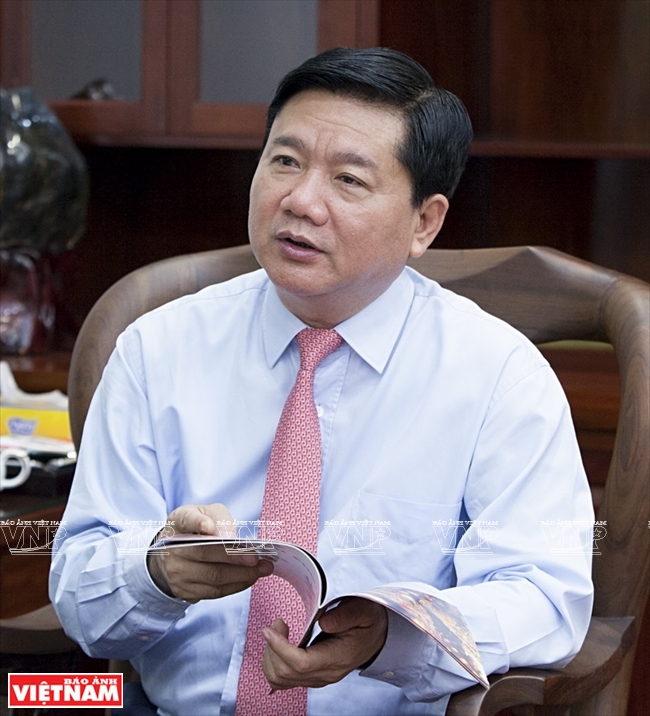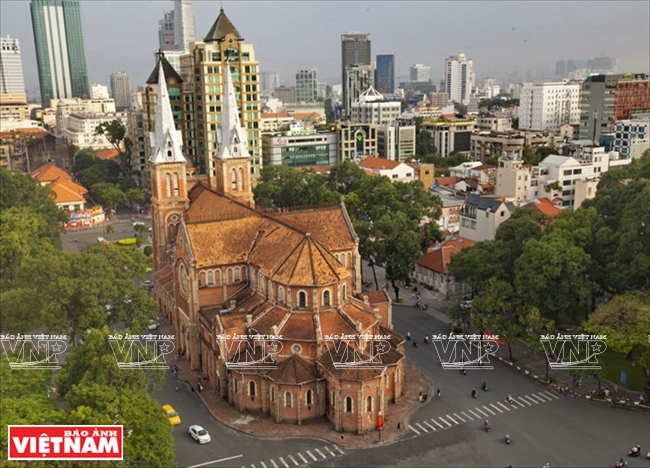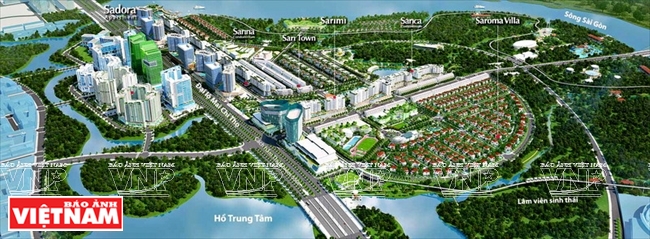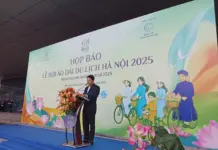It was the confirmation from Politburo member/Secretary of the Ho Chi Minh City’s Party Committee Dinh La Thang when talking with Vietnam Pictorial on the topic “Master plan for the social economic development of Ho Chi Minh City toward 2020 with a vision to 2025”.

Mr. Dinh La Thang, Politburo member/Secretary of Ho Chi Minh City’s Party Committee. Photo: Kim Phuong/VNP
Vietnam Pictorial: According to the “Master plan for the social economic development of Ho Chi Minh City toward 2020 with a vision to 2025” endorsed by the Prime Minister, the city will develop with the focus – multipolar orientation. How will the city make it happen?
Mr. Dinh La Thang: According to the decision, Ho Chi Minh City will develop with the focus – multipolar orientation. The plan will cover the city’s centre and the surrounding areas within 15km. Specifically, the metropolitan area will include district 1, district 3, a part of district 4, BinhThanh district and Thu Thiem New urban complex. In addition, the city will develop to the South and the East (toward the East Sea), and to the Northwest and the West, and Southwest directions.
The idea of developing the city based on directions was initiated in 1998 (excluding the South) but it had not been realised due to the lack of basic infrastructure such as urban areas, public transportation such as electric trains and metros, to connect to the centres. These are important tasks that the city has to settle in the future. In addition, urban areas should be developed with high population density to save the land and reduce harm to the environment.
The city leaders also concentrate on enhancing connectivity by building more highways linked to neighbouring provinces. Meanwhile, the city will cooperate with relevant ministries to build specific policies to exploit the potential advantages of the city, as well as other important economic zones in the South (these include: Ho Chi Minh City, Tay Ninh, Binh Phuoc, Binh Duong, Dong Nai, Ba Ria – Vung Tau, Long An and Tien Giang).

Notre-Dame Cathedral Basilica of Saigon (Nha tho Duc Ba), begun in 1877 and completed in 1880,
is one of the most popular tourist attractions in Ho Chi Minh City. Photo: Kim Phuong/VNP
Vietnam Pictorial: It is estimated that the city’s population will reach 10 million by 2025 and it will become a dynamic city in the world. What will the city do to secure the social security?
Mr. Dinh La Thang: Despite accounting for about 10% of the country’s population and 0.6% of the total area, Ho Chi Minh City generates some 23% of GDP, 30% to the state budget and attracts 20% of total FDI. Those numbers reveal the important role of the city in the country.
One of the reasons behind the above success is the city has been doing well with policies on social security. The city’s Communist Party will continue to further develop its achievements and reduce backwardness and weakness in order to enhance the social security system.
In addition, the city will implement social economic development relating to job creating, encouraging all types of economic segments and sectors while assisting people to get jobs and enhance people’s income.
The city will increase the quality of the insurance system and sustainably alleviate poverty. The city will also increase the implementation of the national plan on building “new rural areas”, which help environment protection, poverty alleviation, job creation and sustainable rural development.
The city will also continue to implement favourable policies on people who contributed to the revolutions and people who are entitled to get social welfare.
The upgrade of the transportation networks and projects like Thu Thiem new urban area,
Vo Van Kiet and Nguyen Van Linh avenues has changed the appearance of the city. Photo: Thong Hai/VNP
Vietnam Pictorial: How will the existing and future urban areas affect the social-economic development of the city?
Mr. Dinh La Thang: Establishment of new urban areas is an indispensable development of the city. New urban areas will boost the quality of the city and will reduce the current shortcomings of the city. New urban areas will not only provide housing but also jobs and social activities for people.
Depending on location, each urban area will have a specific development target. The new urban areas will form metropolitan areas and create a system of urban areas. It is also the development of the city in accordance to the city’s master plan.
The new urban areas are a key solution for the city to change the economic structure. For example, the Thu Thiem New Urban Complex will act as a finance, trading and service hub. Urban areas in the northwest will focus on education, healthcare, and environmentally friendly industries with high added value. District 9 will be a hub of hi-tech industries. The Hiep Phuoc urban area will be the centre for maritime related services and industries.
The new urban areas will promote the city’s competitive advantages in comparison with neighbouring provinces and cities, gradually reducing labour intensive and high pollution industries.
Built by the Vietnamese-Taiwanese joint-venture Phu My Hung Corporation in 1997, Phu My Hung is a showcase
of a modern urban neighbourhood in Vietnam, turning wetlands into a multifunctional urban area. Photo: Kim Phuong/VNP
Vietnam Pictorial: What are the priorities that the city will offer in order to keep it as an investment magnet?
Mr. Dinh La Thang: Ho Chi Minh City is one of the first cities in Vietnam that received investment waves from the world, especially from ASEAN members.
That why over the past few years the city has been drastically renovating its administrative system in order to attract investors. In the future, the city will further synchronise administrative renovation in all sectors in a bid to build an e-government system which will be professional, democratic, modern and dynamic. The city will create a favourable, transparent and fair business environment in order to boost its competitiveness. The city has carried out a number of programs to assist businesses, to promote trade and connectivity in a bid to fully use the city’s advantages, which received positive feedback from the community.
Vietnam Pictorial: Thank you!

Part of the master plan of Thu Thiem New Urban Complex, District 2, Ho Chi Minh City.



